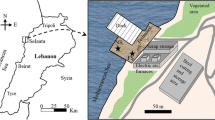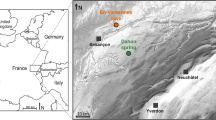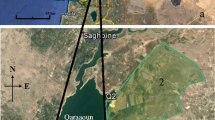Abstract
Temporal changes in pore-water salinity and metal concentrations were investigated in soils from two sites (residential and wetland areas) located in the Old Bridge Township, NJ, after Hurricane Sandy hit the Northeast of the United States of America. Core and surface soil samples were collected in both the residential and wetland sites and then analyzed by field portable X-ray fluorescence (NITON XL3t-600 series FP-XRF). Pore-water salinity was determined from continuous measurements (every 10 min) of conductivity in a single sampling well installed in the wetland site. One month after Hurricane Sandy, pore-salinity was as high as 27 g/L, but gradually decreased to 15 g/L in approximately 3 months. Then, it increased gradually to 26 g/L 3 months later. High metal concentrations (lead, arsenic, copper, chromium, and iron) were measured in the surface and top 2-cm soil layer in both residential and wetland sites, often exceeding background levels within weeks of Hurricane Sandy. These metal contaminations were interpreted as being associated with storm surge from Hurricane Sandy that caused substantial flooding of the coastal areas by large amounts of seawater, loaded with dissolved metal and adsorbed metals to suspended sediments from the Raritan Bay Slag Superfund site. The changes in salinity in wetland areas indicated the intrusion of seawater, thus providing evidence for metal-contaminated seawater altering the wetland’s geochemistry. The transport and deposition of metal contaminants in the coastal areas by Hurricane Sandy increased the risk of human exposure to these contaminants.








Similar content being viewed by others
References
Antoniadis V, Robinson J, Alloway B (2008) Effects of short-term pH fluctuations on cadmium, nickel, lead, and zinc availability to ryegrass in a sewage sludge-amended field. Chemosphere 71:759–764
Dermont G, Bergeron M, Mercier G, Richer-Laflèche M (2008) Metal-contaminated soils: remediation practices and treatment technologies. Pract Period Hazard Toxic Radioact Waste Manag 12:188–209
EPA (United States Environmental Protection Agency) (1998) US EPA Method 6200, field portable X-ray fluorescence spectrometry for the determination of elemental concentrations in soil and sediment
EPA (United States Environmental Protection Agency) (2012) Revised final feasibility study report: Raritan Bay Slag Superfund Site, Old Bridge and Sayreville, New Jersey. CDM Smith, Sept 25, 2012. USACE Contract No. W912DQ‐11‐D‐3004
Fanning D, Rabenhorst MC, Balduff D, Wagner D, Orr R, Zurheide P (2010) An acid sulfate perspective on landscape/seascape soil mineralogy in the US Mid-Atlantic region. Geoderma 154:457–464
Fofonoff N (1985) Physical properties of seawater: A new salinity scale and equation of state for seawater. J Geophys Res: Oceans (1978–2012) 90:3332–3342
Hart BT, Bailey P, Edwards R, Hortle K, James K, McMahon A, Meredith C, Swadling K (1990) Effects of salinity on river, stream and wetland ecosystems in Victoria, Australia. Water Res 24:1103–1117
Jolly ID, McEwan KL, Holland KL (2008) A review of groundwater–surface water interactions in arid/semi-arid wetlands and the consequences of salinity for wetland ecology. Ecohydrology 1:43–58
Kilbride C, Poole J, Hutchings T (2006) A comparison of Cu, Pb, As, Cd, Zn, Fe, Ni and Mn determined by acid extraction/ICP–OES and ex situ field portable X-ray fluorescence analyses. Environ Pollut 143:16–23
Markey AM, Clark CS, Succop PA, Roda S (2008) Determination of the feasibility of using a portable X-ray fluorescence (XRF) analyzer in the field for measurement of lead content of sieved soil. J Environ Health 70:24–29 (quiz 55–6)
Radu T, Diamond D (2009) Comparison of soil pollution concentrations determined using AAS and portable XRF techniques. J Hazard Mater 171:1168–1171
Reddy KR, D’Angelo EM, Harris WG (2000) Biogeochemistry of wetland. In: Summer ME (ed) Handbook of soil science. CRC Press, Boca Raton, pp G89–G119
Schulte EE, Hoskins B (2009) Recommended soil organic matter tests. In: Recommended soil testing procedures for the northeastern United States, 3rd edn. Northeastern Regional Publication, The Northeast Coordinating Committee for Soil Testing (NEC-1012) (revised July 2011)
Sukreeyapongse O, Holm PE, Strobel BW, Panichsakpatana S, Magid J, Hansen HCB (2002) pH-dependent release of cadmium, copper, and lead from natural and sludge-amended soils. J Environ Qual 31:1901–1909
USACE (United Stated Army Corps of Engineers) (2010) Final (revised) data gap evaluation technical memorandum. Remedial investigation/feasibility study Raritan Bay Slag Superfund Site, Old Bridge and Sayreville, New Jersey. CDM Smith, June 2010. USACE Contract No. W912DQ-08-D-0018, Task Order No. 018
USGS (United States Geological Survey) (2013) Monitoring storm tide and flooding from Hurricane Sandy along the Atlantic Coast of the United States, October 2012. In: McCallum BE, Wicklein SM, Reiser RG, Busciolano R, Morrison J, Verdi RJ, Painter JA, Frantz ER, Gotvald AJ (eds) Prepared under amission assignment with the Federal Emergency Management Agency. Geological Survey Open-File Report 2013-1043. http://pubs.usgs.gov/of/2013/1043/
Walker DJ, Hurl S (2002) The reduction of heavy metals in a stormwater wetland. Ecol Eng 18:407–414
Wang Z, Zeng D, Patrick WH Jr (1996) Methane emissions from natural wetlands. Environ Monit Assess 42:143–161
Wang Q, Li Y, Wang Y (2011) Optimizing the weight loss-on-ignition methodology to quantify organic and carbonate carbon of sediments from diverse sources. Environ Monit Assess 174:241–257
Wong VN, Johnston SG, Burton ED, Bush RT, Sullivan LA, Slavich PG (2013) Seawater-induced mobilization of trace metals from mackinawite-rich estuarine sediments. Water Res 47:821–832
Zeng F, Ali S, Zhang H, Ouyang Y, Qiu B, Wu F, Zhang G (2011) The influence of pH and organic matter content in paddy soil on heavy metal availability and their uptake by rice plants. Environ Pollut 159:84–91
Acknowledgments
The inputs of Dr. Lisa B. Axe of New Jersey Institute of Technology (NJIT) are well appreciated. Graduate students Christopher D’Ambrose, Chakravarthy Amoghranganath and Xuanming Zhang helped with field and laboratory work. This research was partially supported by NSF RAPID funding to the Center for Natural Resources Development and Protection under Grant Number (CBET-1313185). The comments provided by the editor and the anonymous reviewers helped improve the manuscript.
Author information
Authors and Affiliations
Corresponding author
Rights and permissions
About this article
Cite this article
Personna, Y.R., Geng, X., Saleh, F. et al. Monitoring changes in salinity and metal concentrations in New Jersey (USA) coastal ecosystems Post-Hurricane Sandy. Environ Earth Sci 73, 1169–1177 (2015). https://doi.org/10.1007/s12665-014-3539-4
Received:
Accepted:
Published:
Issue Date:
DOI: https://doi.org/10.1007/s12665-014-3539-4




